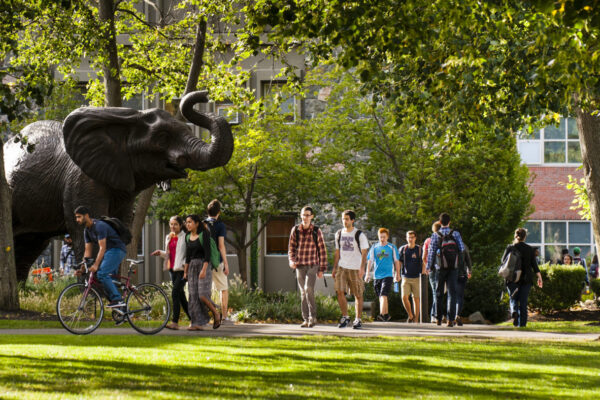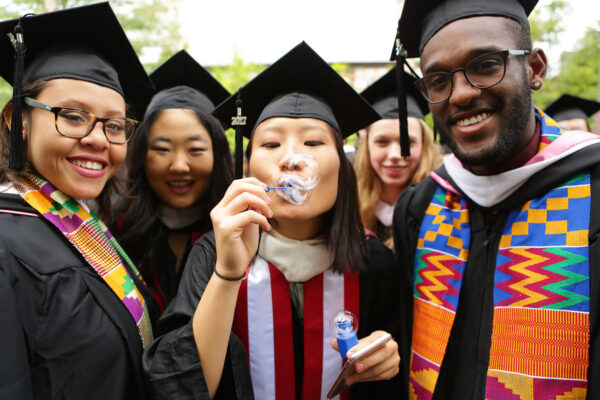By Robin Matross Helms
A few years ago my former ACE colleague Barbara Hill coined the following definition of internationalization: globalization is the movement of people, ideas, goods, capital, services, pollution, and diseases across borders, and internationalization is higher education’s engagement with that reality.
Diseases, indeed. And we certainly are engaged with that reality.
For the last four years or so, the international education field has been grappling with a political landscape that unquestionably has had tangible impacts on our work—travel bans, visa restrictions, and an overall need to justify our work to audiences on campus, in our local communities, and beyond. These challenges are by no means limited to the United States—as Philip G. Atlbach, Hans de Wit, and many others have written, the rise of nationalism in many countries and contexts is changing the state of play for international education around the world.
So we’ve adapted. We’ve learned to be creative in our messaging. We’re seeing the need to view internationalization not as an end in itself, but as a means to achieving the broader missions and goals of our institutions, serving our communities, and—as we discussed at the recent ACE/AIEA Internationalization Collaborative meeting—contributing to the greater global social good. In my blog post last spring, “Going, Golden, Gone: Internationalization’s Past, Present, and Future,” I tried to balance acknowledging our challenges with expressing cautious optimism about the future and applauding the grit and commitment of the professionals in our field. We’ve kept at it—students going back and forth, partnerships flourishing, and global learning still happening.
And then came coronavirus.
While policies and rhetoric may have slowed us down, it’s a virus—perhaps the ultimate manifestation of the downside of globalization—that is stopping us in our tracks. Campuses are closed, study abroad programs have been canceled, and research conferences are in question. Like many colleagues, I’m wondering about my own spring travel—tickets and hotels are booked for Amsterdam and Brasília, but who knows if I’ll actually end up getting on the plane.
But what about student global learning? Coronavirus, ironically enough, illustrates exactly why we need internationalization—we need students who understand global phenomena, can see xenophobic and culture-bound reactions for what they are, and are prepared to work with colleagues around the world to address global crises in the short term, and contribute to long-term solutions through research and the advancement of knowledge.
Study abroad, bringing international students to campus, and developing international partnerships have long been seen as the primary (and best) way to get our students ready for a globalized world. This is reflected in ACE’s 2017 Mapping Internationalization on U.S. Campuses study, which identified the top priority activities for internationalization among U.S. colleges and universities:

The current damper on international mobility is unfortunate, to be sure. But here’s the good news: the most powerful lever for student global learning is not moving people back and forth. It’s what’s happening on our own campuses—namely, our efforts to internationalize the curriculum and co-curriculum, and how we engage our faculty.
Many of us in the field have been saying this for a while. But I have concrete, quantitative data to back it up.
ACE’s Mapping study asks administrators to identify their institutions’ internationalization efforts and activities. The National Survey on Student Engagement’s (NSSE) optional global learning module asks students to identify their own activities and what they have learned. Three years ago, I partnered with NSSE’s Jillian Kinzie to do joint analysis of the data from 56 institutions that had completed both the NSSE global module and the Mapping study. Our goal was to explore the relationship between what institutions say they are doing in terms of internationalization and what students at those same institutions say they are experiencing and learning.
In other words, what institutional efforts are most effective in producing student global learning? The crack team of analysts and NSSE did a rigorous round of number crunching, the details of which we’ll have to wait to explain when we get around to writing the journal article.
There are a variety of caveats to be made about causality, but the results are striking. The punchline: what actually drives student global learning are curriculum internationalization and engaging faculty. When we look at the six pillars of ACE’s Model for Comprehensive Internationalization, the pillars that make the biggest difference in producing student global learning—as reported by students—are “curriculum, co-curriculum, and learning outcomes,” and “faculty policies and practices”:

The six broad categories along the bottom are a composite of indicators from the Mapping study. “Curriculum” includes questions about requirements for students to take globally focused courses and foreign languages, whether there are global learning outcomes specified, and what types of internationally focused co-curricular programs are offered. “Faculty” includes policy-related questions (hiring, tenure, and promotion) as well as whether professional development opportunities are available. There is a positive relationship between investing in curriculum internationalization and student global learning gains, and between faculty policies and practices and global learning gains.
The latter is particularly interesting. Rewarding and incentivizing faculty—policies that seem, at face value, fairly removed from the student experience actually have the greatest impact on student learning. Notably more so than sending students abroad, for example, which is the locus of our current worry.
So, what to do with this information in light of coronavirus?
In the immediate term, we are, warranted or not, in crisis mode. We’re scrambling to assess risks and make sound decisions for our students and our campuses. We need to heed CDC guidance as it emerges, and for many of us, our time and energy are consumed by these tasks. At ACE, we’re working on compiling resources and considering how best to support your efforts—we’ll be housing content and convening discussions on the ACE Engage platform. Stay tuned for more information shortly.
But as the dust settles, we need to be sure we don’t lose sight of student learning. The entire coronavirus situation is a huge potential global learning moment for our students—it touches biology, medicine, cultural studies, communications, public health, politics, policy, and an array of other fields. Encouraging our faculty to incorporate related content into their courses and collaborate with colleagues to provide integrated learning opportunities for students would be a great place to start. Imagine a jointly taught special-edition class session comparing the physical spread of a virus (biology) and the word-of-mouth spread of information (communications).
In addition to promoting immediate subject-related learning, for some campuses, now might be the right time to get serious about Collaborative Online International Learning (COIL). Who better to involve in virtual exchange than a cadre of students who had intended to be abroad this semester, but are now back in our classrooms and eager for global learning? And beyond COIL, there are projects large and small in the curriculum/co-curriculum and faculty realms that we might tackle. How about connecting with the student affairs team to develop a series of residence hall discussions on international issues? Or going further—beginning the process of modifying general education requirements or tenure and promotion policies to include global components?
No doubt about it—coronavirus is a blow. But let’s be sure we and our students find the global learning opportunities inherent in the current situation. And if our trips abroad are canceled, let’s use this found time to our advantage to double down on campus projects. Who knows, maybe I’ll even get that article written.
If you have any questions or comments about this blog post, please contact us.



